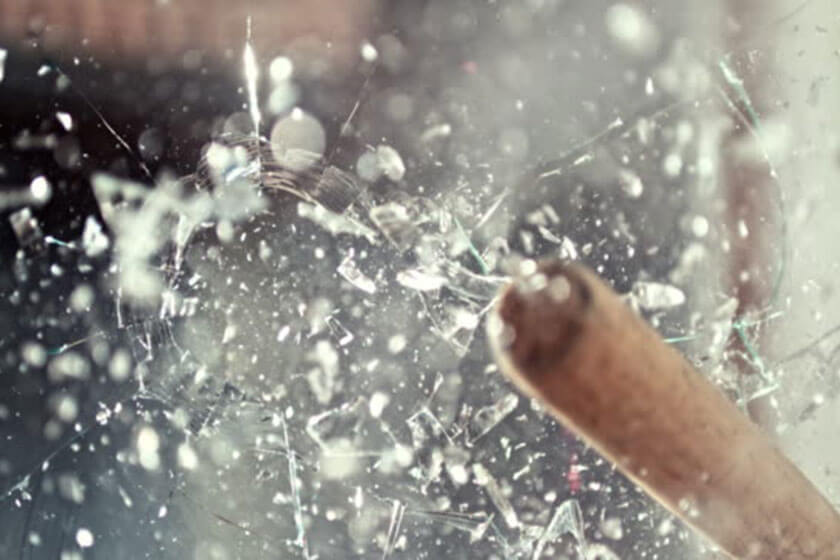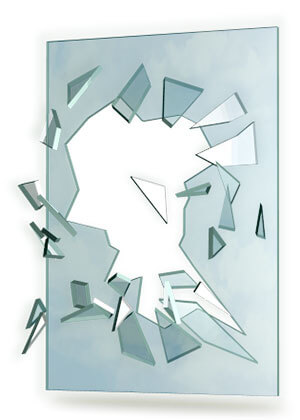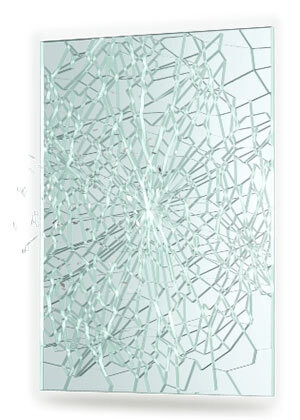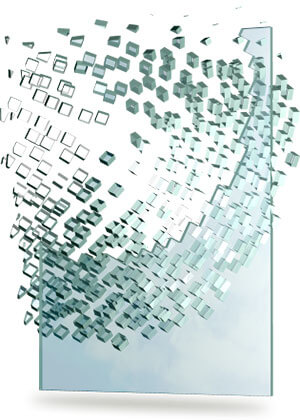Articles
Security Glass
In the past, large glass surfaces were a weak link in the building envelope. Modern, new generation windows have now taken high security remedial measures. Each type of glass has its own properties and advantages. Thus, security glasses, depending on their use and the purpose they serve, are divided into suitable for Passive Securityor Active Security.
Passive SecuritySafety
In Passive Safety, the main purpose is to avoid injury in the event of glass breakage. The relevant scope determines the type and thickness of the glass to either individually or in combination fulfill this purpose.
Active SecuritySecurity
In Active Security, security glazing is used as an active barrier against dynamic attacks. The main goal is to prevent such attacks from penetrating through the glass for a specified period of time.
TEMPERED GLASS
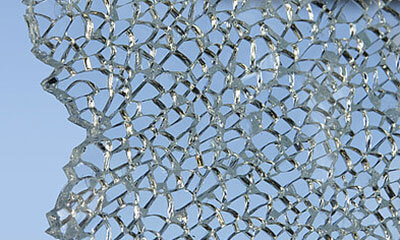
Tempered glass, also known as Securit, was invented in the laboratories of Saint Gobain in 1929. In this process, ordinary glasses are subjected to a heat treatment of toughening (baked), which gives them three outstanding characteristics as Safety Glass:
- They have up to 5 times greater tensile strength than a simple glass of the same thickness. For this reason (according to the EN 12600 standard) they are resistant to shocks from soft deformable objects (such as the human body) and can withstand much higher suction forces or blunt (not sharp) impact.
- Firing also makes the glass more resistant to extreme, short-term changes in hot and cold temperatures, and more able to withstand large temperature differences within its own mass..
- If the glass shatters, it transforms into a mass of non-sharp, loosely joined pieces which, if dropped, will not cause serious injury.
Thermal conductivity, light and energy transmittance, thermal expansion, compressive strength, modulus of elasticity, weight, sound insulation characteristics and chemical properties remain identical to plain glass.
Security
1C3
1C3
1C2
1C2
1C1
1C1
1C1
1C1
Thickness
4 mm
5 mm
6 mm
8 mm
10 mm
12 mm
15 mm
19 mm
Weight
10 Kg/m2
12,5 Kg/m2
15 Kg/m2
20 Kg/m2
25 Kg/m2
30 Kg/m2
37,5 Kg/m2
47,5 Kg/m2
The level of security is determinedby the thickness of the glass
Each thermally treated piece of glass must have a clear and permanent “TEMPERED” marking, according to the EN 12150-3 standard.
LAMINATED GLASS
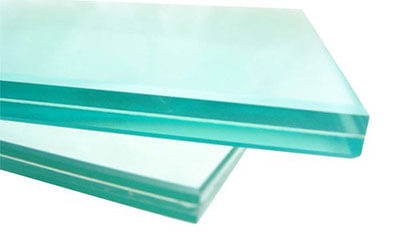
Laminated glasses, or Triplex as they are popularly known, are created by joining two or more single panes of glass with sticky, elastic polyvinyl-butyl (PVB) films of high tear resistance, and can withstand high static loads. Depending on the use, multiple layers of PVB film can be placed between the panes in order to meet the needs of increased demands. The special properties that characterize Triplex glazing are based on the extremely high tensile strength of the PVB layer and its excellent adhesion to the adjacent glass surface.
As for breakage from mechanical stress such as shock, impact or the effect of other forces that eventually break the glass, the pieces in Triplex Safety Glass remain attached to the intermediate membrane, on the one hand preventing the glass from shattering and the collapse of its pieces, on the other hand avoiding falling someone on sharp points of broken glass, thus greatly reducing the risk of injury. In a fully framed installation, the glass shards are contained by the PVB and the glass still maintains a residual strength until it is replaced.
Compressive strength, thermal conductivity, thermal expansion, modulus of elasticity, mass per unit area and chemical characteristics are similar to those of single base glasses.
Light transmittance is a result of the values of processed base glasses and PVB films. Depending on the thickness of the assembly, the light transmission is between 90-70%.
Security
2B2
2B2
1B1
1B1
1B1
1B1
1B1
1B1
Composition
33.1
44.1
55.1
66.1
33.2
44.2
55.2
66.2
Weight
15 Kg/m2
20 Kg/m2
25 Kg/m2
30 Kg/m2
16 Kg/m2
21 Kg/m2
26 Kg/m2
31 Kg/m2
The level of security is determinedby the composition of the mosque
ANTI-VANDAL GLASS

Anti-vandal glazing offers protection against vandalism as well as criminal acts such as burglary, while in no case can they be considered bulletproof. This category includes laminated glass, which has the ability to prevent deliberate movements of criminals and burglars who try to approach objects behind them. The resistance to anti-vandal glazing is of course inversely proportional to the time and means available to the attackers. Consequently the required level of protection varies according to the level of risk.
Class
P1A
P2A
P3A
P4A
P5A
P6B
P7B
P8B
Test
Sphere
Sphere
Sphere
Sphere
Sphere
Ax / Hammer
Ax / Hammer
Ax / Hammer
The level of protection results exclusively from the resistance performance during the tests and regardless of the composition of the glass
BULLETPROOF GLASS

The combination of multiple layers of glasses with interposed, energy-absorbing membranes creates effective bulletproof resistance. For this purpose, a variety of bulletproof glasses are available, of different thicknesses and compositions, depending on the desired degree of protection. The degree of protection is determined by a series of parameters, such as the type of weapon and its caliber, the type of ammunition, the firing distance and the number of hits to prevent the bullet from penetrating the glass. If no tiny fragments are thrown on the protected side of the glass then they are sub-categorized as -NS otherwise as -S.
Cat
BR1
BR2
BR3
BR4
BR5
BR6
BR7
SG1
SG2
Όπλο
Τουφέκιο
Πιστόλι
Πιστόλι
Πιστόλι
Rifle
Rifle
Rifle
Shotgun
Shotgun
Projectile
L/RN
FJ1/RN/SC
FJ1/CB/SC
FJ2/FN/SC
FJ2/PB/SCP1
FJ1/PB/SC
FJ2/PB/HC
FSG
FSG
According to the European Standard EΝ1063
The level of protection results exclusively from the resistance performance during the tests and regardless of the composition of the glass
BLASTPROOF GLASS
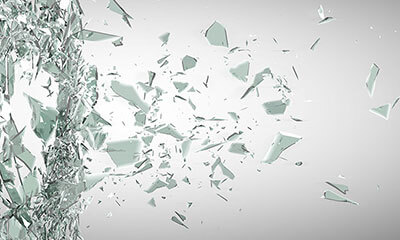
Given the changes in the geopolitical climate and the upsurge in terrorist acts, special blast pressure resistant glass, with the sole purpose of human safety, is the first line of defense and countering the threat of bomb attacks. However, any protection afforded by such special glazing (according to European Standard EN13541), is equally dependent on the design of the structure, its placement and framing as the thrust energy from the explosion is transferred to the load-bearing structure, which will it must be able to withstand.
Cat.
ER1
ER2
ER3
ER4
Pressure
50-100 kPa
100-150 kPa
150-200 kPa
200-250 kPa
Duration
>20 ms
>20 ms
>20 ms
>20 ms
The level of protection results exclusively from the resistance performance during the tests and regardless of the composition of the glass

